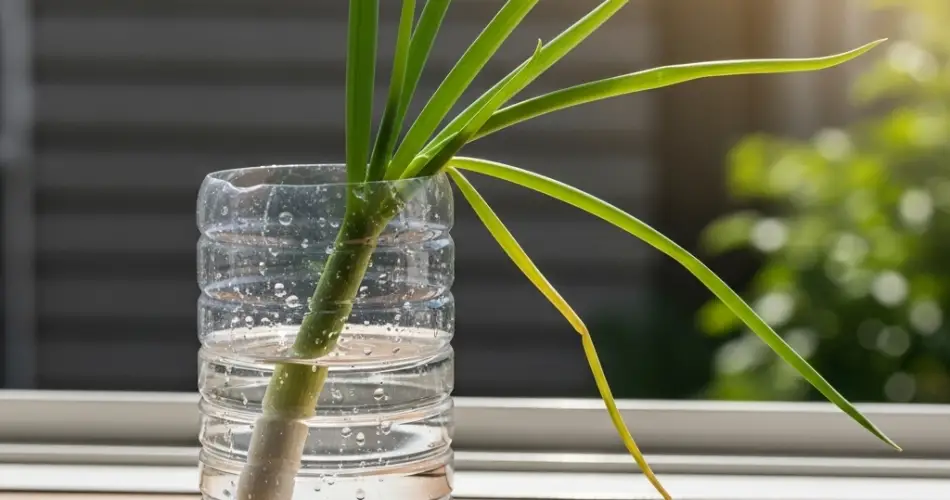Scallions, also known as green onions or spring onions, are a versatile and easy-to-grow kitchen staple. Their fresh, mild flavor works well in countless dishes, and the best part is that you can grow them right at home—even without a garden. With just a few empty bottles, some soil, and a sunny windowsill, you can enjoy a continuous supply of scallions year-round. This simple method not only saves you money but also reduces waste by reusing containers that might otherwise be discarded.
Why Grow Scallions in Bottles?
-
Space-saving: Perfect for small apartments or homes without outdoor space.
-
Fast growth: Scallions regrow quickly and can be harvested multiple times.
-
Low maintenance: Requires minimal care and attention.
-
Eco-friendly: Repurposes bottles, helping reduce plastic waste.
Bottle growing is especially handy for people who like to have fresh herbs and vegetables within arm’s reach in the kitchen.
Materials You’ll Need
-
Clear plastic bottles (1–2 liters)
-
Sharp scissors or a craft knife
-
Potting soil or a light, well-draining mix
-
Scallion bulbs (store-bought or from previous harvests)
-
Water spray bottle or watering can
-
Tray or plate to catch excess water
Step-by-Step Growing Guide
1. Prepare the Bottles
Clean the bottles thoroughly. Cut them horizontally about one-third from the bottom, so you have a deeper section for soil and a shorter top section. You can also cut away the top entirely and use only the base.
2. Add Drainage Holes
Poke small holes in the base of the bottle to allow excess water to drain. This helps prevent soggy soil and root rot.
3. Fill with Soil
Add potting soil, filling the bottle almost to the top. Scallions prefer loose, well-draining soil that retains some moisture but doesn’t stay waterlogged.
4. Plant the Scallions
If using store-bought scallions, trim off the green tops, leaving the white bulbs and roots intact. Insert the bulbs into the soil so that only the tips are visible above the surface. Space them a few centimeters apart to allow for growth.
5. Water Gently
Lightly moisten the soil using a spray bottle or gentle stream of water. Scallions like consistent moisture, but avoid making the soil overly wet.
6. Choose the Right Spot
Place the bottle on a sunny windowsill or in a bright indoor location. Scallions thrive in full sun but can also tolerate partial light.
Caring for Your Scallions
-
Watering: Keep the soil lightly moist, especially in warm indoor environments.
-
Feeding: For stronger growth, feed with a diluted liquid fertilizer every 2–3 weeks.
-
Harvesting: Once the green stalks reach 15–20 cm in height, snip them just above the white bulb. The scallions will regrow, allowing multiple harvests from the same plants.
With proper care, each bulb can regrow several times before eventually losing vigor.
Tips for Maximizing Your Harvest
-
Stagger planting: Plant a few bulbs each week to ensure a constant supply.
-
Replant regularly: Replace older bulbs with fresh ones for continued production.
-
Avoid overcrowding: Give each bulb enough room to grow healthy, thick stalks.
-
Rotate bottles: Turn them every few days to ensure even sunlight exposure.
Benefits of the Bottle Method
-
Cost savings: Regrowing scallions from kitchen scraps reduces grocery expenses.
-
No garden required: Ideal for apartment dwellers or anyone with limited space.
-
Year-round harvest: Grow fresh scallions regardless of the season.
-
Sustainable gardening: Reusing bottles cuts down on plastic waste.
This method is also a great way to introduce children to gardening. Watching scallions sprout and grow so quickly can be a fun and educational activity.
Troubleshooting Common Issues
-
Yellowing leaves: This may indicate overwatering or insufficient sunlight. Adjust watering habits and move the bottles to a sunnier spot.
-
Slow growth: Try adding more light or feeding with a balanced fertilizer.
-
Mold on soil surface: Reduce watering frequency and improve air circulation.
From Windowsill to Table
One of the best parts of growing scallions in bottles is the convenience. When you need them for cooking, simply snip what you need and let the rest continue growing. Fresh scallions add a crisp, mild onion flavor to soups, salads, stir-fries, omelets, and more.
With minimal space, a few empty bottles, and a little care, you can transform your windowsill into a mini scallion farm. Not only will you enjoy fresher flavors in your meals, but you’ll also take a small but meaningful step toward sustainable living.



